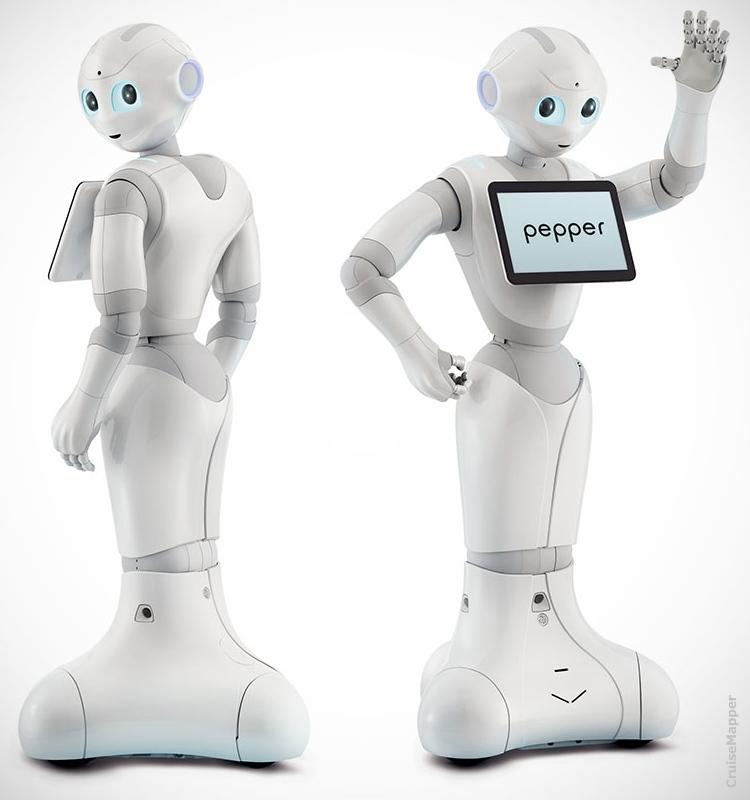An innovative AIDA Cruises and Costa Cruises fleetwide program implemented the latest cyborg technology in both Carnival Corporation-owned fleets. Humanoid robots now greet and guide passengers upon embarkation. They also assist them throughout the voyage by providing information and tips on dining (restaurants, bars), entertainment (lounges, scheduled events, lectures and presentations, onboard casino and shopping promotions), shore excursions and tours (offered in ports of call along the cruise itinerary).
Pepper robot
The "cruise ship robots" (named Pepper) are able to communicate in 3 different languages (English, German, Italian), to move fluidly, and even to interpret human emotions by analyzing voice tones and face expressions.

Designed by the companies Aldebaran Robotics (now Softbank Robotics), the Pepper robot was launched in Japan (June 2014) as the world’s first “emotional” robot. The machine's main statistics are:
- height 120 cm / 4 ft
- weight 28 kg / 62 pounds
- 3x wheels (omnidirectional)
- 17x joints
- 1x 3D depth sensor
- 2x HD cameras
- 4x microphones
- touch sensors (in its head and hands)
- a 10-inch (25 cm) touch screen
The new technology was first tested on the AIDAstella ship where Pepper learned to engage with passengers and crew. The first set of robots were introduced on Costa Diadema and AIDAprima in April 2016. By the end of summer 2016, Pepper robots were added on all AIDA and Costa's vessels.
Humanoid robots
Peper is an autonomous humanoid robot (resembling the human body) which development started in 2004 with "Project NAO" (pronounced "now"). The robot was developed and initially used for research and educational purposes only. It was first released to institutions in 2008. Since 2011, the robot is publicly available (including to private companies and owners). The project's most significant upgrades were made in 2011 (Nao NextGen) and 2014 (Nao Evolution). In 2015, over 5000 units were used in 50+ countries.
Besides the NAO model, following Aldebaran's acquisition by SoftBank Group (headquartered in Tokyo Japan), the company also developed the humanoid models Romeo and Pepper.
- These three robots have different objectives. NAO is geared towards science (programming, teaching, research). Romeo is a support robot for helping people with loss of autonomy, Pepper is specializing in customer relations. Karotz is a rabbit-shaped computer connecting to the Internet through Wi-Fi.
- The first Romeo robot was launched in 2009. The project was funded by Bpifrance (French public investment bank) and is based on collaboration with various research laboratories and institutions in Europe. In May 2010 was revealed the robot's first 3D rendering. In November 2012, Aldebaran launched the project "ROMEO 2".
- The robot NAO is used by numerous academic institutions (colleges and universities) and schools worldwide. It specializes in teaching programming and conducting human-robot interaction (psychology) researches. Since 2012, NAO robots are used by numerous UK schools to teach autistic kids. In 2015, Mitsubishi started trialing NAOs for customer services in the company's bank branches in Japan.
SoftBank Robotics
The robot's developer Aldebaran Robotics was a French company (now Japanese) headquartered in Paris France. In 2015, the company was acquired by SoftBank Group and renamed/rebranded to "SoftBank Robotics". SoftBank Robotics is a Japanese company specializing in the field of humanoid robotics.
- Aldebaran Robotics was created by Bruno Maisonnier on July 8, 2005.
- NAO's first humanoid robot version was unveiled in 2006.
- The Karotz ("rabbit robot") was developed by the Violet company, which in 2011 was acquired by Mindscape. On October 6, 2011, Mindscape was bought by Aldebaran. The robot was officially launched on April 1, 2011. The project's maintenance was ended on February 18, 2015.
- In July 2012, Aldebaran Robotics acquired the company Gostai (specializing in robot design and artificial intelligence software).
- On March 13, 2012, 78,5% of Aldebaran Robotics' capital was purchased by SoftBank for USD 100 million.
- In March 2015, SoftBank bought Bruno Maisonnier's shares and increased its shareholding to 96%. SoftBank's President Fumihide Tomizawa was named CEO of Aldebaran Robotics.
- In May 2016, the company was renamed to SoftBank Robotics.